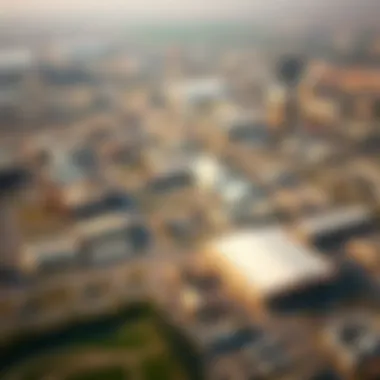Exploring Dubai Industrial City: A Comprehensive Overview


Intro
Dubai Industrial City (DIC) stands as a cornerstone in the vibrant economic landscape of the UAE. With its strategic location just 30 minutes from Dubai’s city center and proximity to major transportation routes, DIC plays a crucial role in the logistics and industrial sectors. Its design reflects an integrated approach, combining a variety of zones catering to manufacturing, logistics, and retail, thus creating a dynamic environment for businesses to thrive.
DIC offers a comprehensive solution to the challenges faced by investors and corporations. The city’s infrastructure is equipped with state-of-the-art facilities, transport links, and utility services, making it an attractive proposition for both local and international firms. By tapping into this hub, organizations can leverage its advantages to enhance their operations and supply chains.
As the global economy evolves, understanding the intricate workings of DIC becomes paramount for investors and businesses targeting growth in the region. The following sections delve into the current market trends, the diverse property types available, and the promising future that lies ahead for Dubai Industrial City.
Intro to Dubai Industrial City
Dubai Industrial City (DIC) is emerging as one of the most critical industrial hubs in the United Arab Emirates. The significance of DIC lies not only in its physical infrastructure but also in its strategic vision to bolster industrial growth and economic diversification in the region. As the UAE aims to transition from an oil-dependent economy to a more diverse one, understanding what DIC offers becomes essential for various stakeholders including investors, home buyers, real estate agents, property managers, and renters alike.
This section aims to unpack the essence of Dubai Industrial City, laying a groundwork for further exploration into its geographical setting, zoning features, and economic implications.
Defining Dubai Industrial City
Dubai Industrial City serves as a sprawling industrial complex located strategically near key commercial areas. It covers an impressive area, which makes it a vital player in the industrial landscape of Dubai. The city encompasses multiple industrial zones classified into logistics, manufacturing, and more specialized areas to accommodate a range of businesses.
Understanding what DIC represents goes beyond just an expanse of land; it is a well-structured ecosystem designed to nurture industries such as light manufacturing, logistics, and assembly operations among others. This quality makes it an attractive location for companies looking for efficient operational setups. Major global companies have also recognized its potential and established their presence here, further enhancing its stature.
To put it simply, DIC is a well-conceived entity that aims to bridge the gap between a rapidly transforming economy and the logistical demands of a burgeoning market, making it indispensable.
Historical Context
The evolution of Dubai Industrial City intertwines seamlessly with the broader narrative of the UAE's economic development. Established in the early 2000s, DIC was conceived during a period when Dubai was aggressively pushing to diversify its economy away from oil reliance. The foresight of leadership saw the necessity for a dedicated industrial zone that would not only attract foreign investment but also create localized job opportunities.
Over the years, DIC has undergone continuous development, transforming from vacant land into a robust industrial community. One pivotal moment was the global financial crisis in 2008, which tested its resilience. The city adapted, focusing on sustainability and efficiency, lessons learned from global economic shifts.
While still relatively young, the historical context surrounding DIC highlights its strategic importance in an ever-evolving economic landscape. As industries worldwide face new challenges, DIC stands as a resilient example of proactivity and adaptability.
Location and Geographical Context
Understanding the location and geographical context of Dubai Industrial City (DIC) is crucial for grasping its significance as an industrial and logistics hub. DIC’s location is not just a dot on the map; it embodies a thoughtful convergence of trade routes and accessibility that offers profound advantages for businesses and investors alike.
Strategic Positioning of
Dubai Industrial City sits centrally within the larger economic framework of the UAE, easily accessible from key metropolitan areas. This strategic positioning allows for seamless movement of goods and services, which is vital for any industrial operation. Located just off the Sheikh Mohammed bin Zayed Road, one of the primary arterial roads in the emirate, DIC connects well to other major highways and cities.
Moreover, its proximity to the Jebel Ali Port, the largest man-made harbor in the world, enhances its appeal. Businesses can take advantage of quick shipping and customs clearance, minimizing transit times significantly. Companies engaged in import-export activity find this ideally suited for international trade, reducing logistical hurdles considerably.
Additionally, companies in DIC benefit from proximity to Dubai South and the Dubai World Central Airport. This integrated transport ecosystem allows for efficient air and sea freight solutions, fostering a more productive supply chain. The strategic positioning of DIC does more than provide physical proximity; it symbolizes accessibility that allows enterprises to thrive in a fast-paced market.
Access Points and Major Routes
Dubai Industrial City boasts multiple access points that facilitate easy transport for both people and products. High-capacity road networks and extensive connectivity are two of the crucial features that make DIC a prime location for businesses.
The main road access includes:
- Sheikh Mohammed bin Zayed Road: providing a direct conduit to Dubai and its surrounding areas.
- Emirates Road: an alternative route that connects to the wider UAE network.
- Al Maktoum International Airport: enabling easy freight solutions.
For businesses, these routes are more than just directions; they represent the backbone of logistics that allow for effective distribution channels. The location here helps minimize travel time, thereby cutting operational costs significantly.
Furthermore, public transportation options, including bus services, enhance accessibility for employees, making it easier for skilled labor to reach their workplaces seamlessly.
"The proximity to major routes and airports creates a logistical playground for businesses, where time is just as essential as space."
In summary, the geographical context and strategic positioning of Dubai Industrial City are pivotal for its standing as an industrial powerhouse. With efficient access points and a well-connected road network, businesses are positioned well for success. Understanding this landscape is paramount for investors looking to tap into the wealth of opportunities that DIC presents.
Zoning and Infrastructure
Zoning and infrastructure play a crucial role in shaping the operational efficiency and overall attractiveness of Dubai Industrial City (DIC). This section elucidates the various components of zoning, alongside the essential infrastructure that supports the day-to-day functions of businesses operating within its boundaries. Understanding these elements can provide insights for investors, real estate agents, and other stakeholders who seek to navigate this dynamic industrial landscape.
Industrial Zones Overview
Within Dubai Industrial City, the zoning is meticulously organized to cater to diverse industrial requirements. Each zone is designed with specific sectors in mind, making it easier for industries to find a compliant space that meets their needs. For instance, there are zones aimed at heavy manufacturing, light industries, and logistics—each tailored to optimize operations and supply chain dynamics. This thoughtful zoning approach enhances collaboration among similar businesses, fostering innovation while minimizing operational disruptions.
Furthermore, accessibility is paramount within these zones. Business parks are strategically situated near key transportation routes, ensuring that companies can easily transport their goods and services. This setup empowers businesses by allowing them to reduce transport costs, leading to an overall increase in profit margins. More importantly, having a diverse range of industries in close proximity promotes a more vibrant economic ecosystem.
"DIC’s organized structure not only simplifies operations for businesses but also enhances the overall investment appeal of the area."
Another noteworthy aspect is the integration of modern facilities within the industrial zones. Companies benefit from state-of-the-art utilities and essential services such as waste management, security, and maintenance, provided by the administration of the area. Such facilities are fundamental for ensuring that businesses can focus primarily on their operations instead of dealing with external logistical challenges.
Logistics and Warehousing Facilities
Logistics and warehousing facilities in Dubai Industrial City have been developed with an eye towards creating a world-class supply chain hub. These facilities are designed to streamline the movement of goods, leveraging advanced technology and strategic location advantages. With immediate access to major roads and cargo hubs, businesses can expedite their shipping processes, an essential factor for maintaining competitive advantage in today’s fast-paced market.


The warehousing options range from simple storage solutions to sophisticated distribution centers equipped with the latest technology. Many of these warehouses come with features such as temperature control, advanced inventory management systems, and high-capacity loading docks, allowing businesses to efficiently handle a variety of goods.
Moreover, the collaborative atmosphere of DIC encourages logistics providers and businesses to partner up. This synergy leads to efficiency improvements through shared resources and knowledge. Additionally, with the rise of e-commerce, tailored logistics solutions are being continually introduced, which keeps the city at the forefront of modern industrial evolution.
Economic Significance
The economic significance of Dubai Industrial City (DIC) cannot be overstated. This vibrant hub stands not only as a beacon of industrial growth but also as a cornerstone in the broader economic landscape of Dubai and the United Arab Emirates. Understanding its impact is essential for investors, businesses, and policymakers alike. DIC’s role as a logistics and manufacturing powerhouse reflects its importance in supporting local industries, attracting foreign direct investment, and enhancing export capabilities.
Contribution to Dubai's Economy
Dubai Industrial City plays a vital role within the fabric of the emirate’s economy. By hosting a diverse range of industries, it diversifies the economic base of the region. Here are some key aspects of its contribution:
- Industrial Growth: DIC serves as a platform for industries including logistics, food processing, and heavy manufacturing. This fosters resilience against economic fluctuations.
- Foreign Investment: The city's infrastructure and strategic location have attracted numerous international firms looking to set up operations in the Gulf region. This investment surge contributes to increased GDP, paving the way for a robust economic environment.
- Export Hub: With its emphasis on logistics, businesses within DIC are well-positioned to engage in trade. The accessibility to major shipping routes allows companies to export goods efficiently, further propelling Dubai's economy on the global stage.
The ripple effect of these elements cannot be ignored. A thriving industrial sector bolsters other economic sectors, creating a domino effect that elevates overall economic performance.
Employment Opportunities
DIC stands as a significant employment generator in Dubai. The area not only creates jobs but nurtures a diverse workforce, contributing to the emirate's socio-economic fabric. The following points illustrate its impact on employment:
- Job Creation: As industries grow, so do job opportunities. DIC hosts thousands of businesses, leading to a high demand for skilled and unskilled labor alike. Thus, residents find various employment options within proximity.
- Training and Skill Development: Many companies in DIC invest in training programs for their employees. This not only empowers the local workforce with essential skills but also enhances productivity across the board.
- Local and Global Talent: The combination of local job seekers and expatriates looking for opportunities creates a melting pot of talent. This environment fosters innovation, drawing in individuals from various industries and backgrounds.
"Dubai Industrial City epitomizes the integration of industrial growth with economic resilience, creating an invaluable asset for the UAE's economy."
For more information about Dubai Industrial City's impact and initiatives, check out Dubai Logistics City and the UAE Economic Overview.
- Related Links:
By examining the elements of economic significance, stakeholders can approach Dubai Industrial City as a strategic opportunity for long-term investments and sustainable growth.
Transportation Links
The transportation infrastructure in Dubai Industrial City (DIC) holds immense significance, not just for the businesses that operate within its expanse but also for the broader economic landscape of the UAE. An effective transport network enhances efficiency, reduces operational costs, and attracts further investment. Essentially, it creates a lifeline that connects industries with markets, suppliers, and consumers, facilitating seamless commercial activities. Let's delve into the aspects of road connectivity and cargo shipping channels, each of which forms a critical component of DIC's transportation framework.
Road Connectivity
DIC's road network is the veins and arteries that pump life into its vibrant industrial scene. The city is strategically positioned near major roadways, ensuring easy access to global markets.
- Major Roads: Key highways such as Emirates Road and Sheikh Mohammed Bin Zayed Road are in close proximity, making it a breeze for trucks and vehicles to maneuver through the urban sprawl of Dubai.
- Accessibility: Quick access to these highways not only enables faster delivery times but also minimizes transit costs for businesses. This ensures that companies can move products efficiently, a crucial factor in maintaining competitiveness.
- Local Routes: The internal road system within DIC is designed without unnecessary detours or complicated turns, which enhances logistics planning and optimizes transport workflows.
There's more than just roads at play. The connectivity comes with a promise of reduced congestion and efficient traffic management. With ample lanes and synchronized traffic light systems, delays are a rarity, allowing for smooth operations.
"Effective road connectivity serves as a catalyst for industry growth, fostering an environment where businesses can thrive and expand."
Cargo and Shipping Channels
When discussing transportation links, it’s impossible to overlook the importance of cargo and shipping channels in Dubai Industrial City. This region boasts exceptional port access, positioning DIC as a key player in international trade.
- Proximity to Ports: Located a stone's throw from the Jebel Ali Port, one of the busiest ports globally, DIC enjoys a logistical advantage that few industrial zones can boast. This means reduced handling times and streamlined import and export procedures.
- Multimodal Transportation: The combination of road and port facilities offers a multimodal transport solution, allowing businesses to select the best methods for delivering goods. Companies can ship by sea and then transfer to road networks without missing a beat.
- Customs Support: With dedicated customs services nearby, businesses can expect expedited clearance times, further enhancing operational efficiencies. This can significantly reduce the lead times for goods entering or leaving the city.
In summary, the transportation links of Dubai Industrial City are not just practical; they are a backbone for economic activity. The interplay between road connectivity and shipping options creates a thriving hub for trade and commerce, earning DIC its reputation as an industrial powerhouse. As businesses keenly evaluate their logistics strategies, the advantages presented by these transport links cannot be overstated.
Utilities and Services
Understanding the utilities and services available in Dubai Industrial City is fundamental for investors, businesses, and even renters interested in making a home in this vibrant area. Reliable access to utilities such as electricity, water, and telecommunications plays a critical role in not just day-to-day operations but also in attracting potential investors looking for a conducive environment to set up their businesses.
Electricity and Water Supply
Electricity and water are the lifelines of any thriving industrial zone, and Dubai Industrial City is no exception. This area boasts a robust electricity supply, backed by the Dubai Electricity and Water Authority (DEWA). The infrastructure is designed to support heavy industrial activities, ensuring that businesses have uninterrupted access to power.
Moreover, the city has invested in sustainable practices, utilizing modern technologies to enhance energy efficiency. This is not just about power; it's about ensuring that companies can rely on consistent energy sources without facing unexpected outages. The importance of having a reliable water supply cannot be overstated, as this facilitates the smooth operation of factories and manufacturing plants.
"In an industrial setting, the reliability of power and water supply is as crucial as the machinery itself."
As businesses continue to grow, the infrastructure has the capacity for expansion, allowing for an increase in supply without major disruptions. This ensures that companies can scale their operations without worrying about utility constraints.
Telecommunications Infrastructure
In an age where connectivity drives efficiency, the telecommunications infrastructure in Dubai Industrial City stands out. With high-speed internet and advanced telecommunications services, businesses can stay connected to clients, suppliers, and markets across the globe.
The local telecommunications companies offer a range of services, including fiber-optic internet, mobile networks, and dedicated lines suitable for heavy bandwidth activities. This makes the city an attractive location for technology-driven companies and those in data-heavy sectors.
- Benefits of Strong Telecommunications Infrastructure:


- Facilitates seamless communication.
- Enhances operational efficiency through reliable connectivity.
- Supports advanced technologies like IoT and automated systems.
The aim is to provide a solid foundation for businesses, irrespective of their size or operational scale. Investors can feel confident knowing that their communications needs will be effectively met, allowing them to focus on growth instead of bureaucratic hassles.
In essence, the utilities and services framework in Dubai Industrial City is meticulously crafted to meet the demands of a modern industrial hub. From consistent electricity and water supply to a robust telecommunications network, these elements contribute immensely to the overall attractiveness of DIC as a prime investment location.
For more on utility services in Dubai, you can check Dubai Electricity and Water Authority and get insights into local telecommunications from du.
Investors, home buyers, and business owners all have compelling reasons to consider Dubai Industrial City when evaluating potential locations for their ventures.
Development and Expansion Plans
Understanding the development and expansion plans of Dubai Industrial City (DIC) provides insights into its position as a robust player in the UAE's industrial landscape. Growth in this sector not only signifies the city's aspirations but also reflects on regional and global economic trends. These plans demonstrate commitment toward fostering innovation and sustaining industrial activities in line with international standards.
Current Projects
As of now, DIC is actively rolling out several projects aimed at enhancing its infrastructure. One notable initiative is the Dubai Logistics City (DLC), a project designed to streamline logistics operations. This project is crucial for businesses involved in trade and distribution, enabling them to cut down on delivery times and cost effectively manage their supply chains.
Another project worth mentioning is the Green Industrial Zone, which seeks to promote sustainability within industrial practices. Facilities in this zone are specifically designed to minimize environmental impact, tapping into renewable resources and energy-efficient technologies. This endeavor emphasizes not only profitability but also responsibility toward ecological preservation.
In addition to these, several warehouses and manufacturing units are also in various stages of construction, projected to be completed in the next couple of years. Here are some examples of the current projects:
- Logistics Centres: Designed to support freight and warehousing.
- Manufacturing Facilities: Equipped to cater to industries ranging from textiles to electronics.
- Research and Development Units: Promoting innovation in various sectors.
Future Growth Potential
Looking ahead, the future of Dubai Industrial City appears to be as bright as the UAE sun. The economic diversification efforts of the UAE also heavily influence this growth potential. With the government’s objective to elevate non-oil sectors, DIC stands to gain significantly. The integration of high-tech solutions in logistics and production processes can further enhance the city’s attractiveness to investors.
Moreover, ongoing dialogues around establishing free-trade agreements within the region could open up new markets for companies based in DIC. The potential for foreign direct investments will likely increase as well, considering the positive regulatory environment.
The planned expansion of transportation links, such as the enhancement of nearby highways and transport hubs, is also positioned to attract more businesses in the coming years.
"The development of Dubai Industrial City has not only fortified the local economy but also paved the way for a more interconnected global marketplace."
Investors, home buyers, and real estate agents should particularly watch for:
- Increased investment from multinational corporations.
- Innovations in technology adoption driving productivity.
- Better transport options boosting logistics efficiency.
Investment Opportunities
Investment opportunities in Dubai Industrial City (DIC) stand as a beacon for businesses and entrepreneurs eager to tap into the UAE's thriving market. The city's strategic design focuses on providing entrepreneurs a fertile environment for their ventures. Notably, it's not just about the physical space; it's about the ecosystem that supports growth.
Attractiveness for Investors
When we look at why DIC is so attractive to investors, several factors come into play. First and foremost is its strategic location—nestled within a robust logistics framework that connects firms directly to key markets in the region and beyond. It's an undeniable advantage that can’t be overlooked. Plus, the proximity to major road networks and ports facilitates a seamless flow of goods. Imagine reducing transit times significantly; that's the advantage DIC brings.
Moreover, the diversity of sectors represented in DIC—from manufacturing to logistics—ensures investors have a variety of options at their disposal. The chance to partner with established firms enhances viability and can open doors that otherwise remain closed.
Another notable point is the government support for foreign investors. Over the years, the UAE has built a reputation as a business-friendly destination, offering competitive incentives such as tax exemptions and 100% foreign ownership in certain sectors. It's as if the government has consciously designed the environment to ensure that investment flourishes.
"A supportive regulatory landscape coupled with strategic positioning makes DIC a prime spot for investment."
Regulatory Framework
A sound regulatory framework is an essential part of any thriving investment environment, and DIC does not fall short. The regulations governing investment in DIC are designed to simplify processes and provide a clear path for new businesses.
For instance, business establishment in DIC is straightforward. Investors find that the approval processes are relatively quick when compared to other jurisdictions. This speed not only saves precious time but also allows businesses to become operational pronto.
Moreover, the local authorities actively engage with investors to ensure that their needs are met, which fosters a sense of community. Regular workshops and seminars keep everyone informed of changes in regulations or new opportunities. Being part of this ecosystem means being plugged into the latest developments—a critical factor in navigating the competitive landscape.
In summary, the regulatory framework of DIC works to enhance not only the attractiveness of the investment but also the security of investors’ stakes. Coupled with strategic location and government backing, it creates an attractive proposition, urging conscientious investors to make their mark in one of the UAE's industrial powerhouses.
Investors, home buyers, and real estate agents would do well to consider the growing potential of DIC. Making informed choices here can lead to fruitful ventures that resonate well into the future.
Environmental Considerations
Understanding the environmental considerations surrounding Dubai Industrial City (DIC) is crucial for multiple stakeholders, from investors to local residents. As the world becomes more aware of sustainability and ecological balance, it’s pertinent to recognize how DIC engages with these priorities. Environmental considerations encompass sustainability initiatives and the impact on local ecosystems, both vital for fostering a responsible industrial environment.
Sustainability Initiatives
Dubai Industrial City aims to reduce its carbon footprint and enhance operational efficiencies through a series of sustainability initiatives. Many factories and businesses within DIC have adopted renewable energy practices. For instance, solar panels adorn the rooftops of several facilities, harnessing the UAE’s abundant sunlight to power operations. This not only minimizes reliance on fossil fuels but also significantly cuts energy costs over time.
Another notable initiative includes waste management programs in collaboration with local authorities. DIC encourages its tenants to adopt recycling practices, reducing landfill waste. These programs focus on the segregation of recyclable materials and safe disposal of hazardous waste, ensuring that companies adhere to environmental regulations while contributing to a greener future.
In addition, there are investments in water-saving technologies. Smart irrigation systems and recycling of industrial water are just a couple of the methods utilized to ensure efficient water use, which is critical in a region known for its arid climate.


"Sustainability is no longer an option; it's a responsibility that every business must embrace to thrive in the modern world."
Impact on Local Ecosystems
DIC is not just an industrial zone—it is nestled within a complex web of ecosystems. Understanding its impact on local wildlife and habitats can inform better practices and careful planning. The development has been strategically designed to limit disruption to the environment. Buffer zones around sensitive habitats help mitigate the effect of industrial activity on natural areas.
Furthermore, DIC conducts environmental assessments to understand its operations' ecological footprint before starting new projects. These assessments evaluate potential impacts on flora and fauna, thus allowing for minimization strategies to be put in place. For example, in areas where construction might threaten local species, measures such as relocation and habitat restoration are prioritized.
Investors and companies looking to set up in DIC should recognize that addressing these environmental factors can foster goodwill within the community. Commitment to preserving the local ecosystem not only fulfills corporate social responsibility but also enhances long-term viability in a market that increasingly favors sustainability.
In summary, the environmental considerations surrounding Dubai Industrial City present a dual opportunity: to expand economically while respecting and preserving the natural environment. This synergy can lead to sustainable growth that benefits both the industrial sector and the local communities, forging a resilient path forward for the region.
Case Studies
Importance of Case Studies in
Case studies play a vital role in illustrating the practical applications and successes that define the Dubai Industrial City (DIC). They provide a concrete representation of how theories and plans translate into real-world results. For investors and business owners, these examples can serve as powerful indicators of potential success and opportunities within DIC.
Case studies shed light on the diverse industries thriving in this industrial hub. Analyzing specific examples often reveals insights into market trends, operational efficiencies, and innovative growth strategies that can inspire new initiatives. By examining success stories, stakeholders can identify best practices, potential pitfalls, and unique characteristics that make DIC an attractive locale for business operations.
"Case studies are the window through which one can explore the depth of potential within an economic landscape like Dubai Industrial City."
Successful Businesses in
Dubai Industrial City is home to a multitude of successful companies across varying sectors. These businesses thrive in an environment tailored for growth and innovation.
- Procter & Gamble: This multinational giant utilizes DIC's resources for efficient manufacturing and distribution. Their success in this zone lies in effective supply chain management and strategic location.
- Al-Futtaim Group: Known for operations in automotive, retail, and real estate, Al-Futtaim leverages DIC's infrastructure for their logistics and warehousing needs. Their strategic investments highlight the adaptability required for modern industrial operations.
- DB Schenker: This global logistics provider has established a significant footprint in DIC, benefiting from seamless access to key transport routes. Their success illustrates how logistics companies can thrive in an integrated infrastructure environment.
These firms exemplify how tapping into DIC can result in operational advantages, cost efficiencies, and enhanced market presence, demonstrating the value of establishing operations in this well-strategized industrial area.
Partnerships and Collaborations
Collaboration often catalyzes business growth, and DIC fosters a collaborative spirit among its tenants. Partnerships within this industrial city not only enhance individual business potential but also contribute to the overall ecosystem.
- Public-Private Partnerships: The collaboration between government entities and private sector players helps streamline regulatory processes and provide essential services. This interaction often results in more efficient project execution and smoother business operations.
- Joint Ventures: Companies within DIC sometimes opt for joint ventures to share resources and expertise. Such partnerships can lead to innovative solutions and product offerings that leverage the strengths of both parties, enhancing competitiveness.
- Networking Events: DIC regularly hosts events facilitating networking among various businesses. These gatherings foster relationships that can lead to projects, ideas, and collaborations that are mutually beneficial.
The partnerships formed here are not just about co-location; they extend to shared goals, visions, and resources that amplify success rates for companies operating in Dubai Industrial City.
Challenges and Considerations
Navigating through the intricacies of Dubai Industrial City (DIC) undoubtedly requires an understanding of the challenges and considerations that shape its operational landscape. For investors, business owners, and stakeholders, recognizing these challenges isn’t just about identifying potential hurdles; it’s also about leveraging them to make informed and strategic decisions. The significance of this section lies in dissecting specific elements that can impact growth, stability, and sustainability within this hub.
Infrastructure Constraints
Infrastructure is the backbone of any industrial area, and DIC is no exception. It's like the vital arteries that circulate life through a bustling city. However, some constraints have raised eyebrows among businesses looking to set up shop or expand. First and foremost, while DIC has robust existing infrastructure, there's a constant need for upgrades to keep pace with the rapid technological advancements and increased demand.
Moreover, access to high-speed internet and other digital services can sometimes be patchy, which poses challenges for tech-driven industries. The reliance on traditional infrastructure can sometimes restrict innovative business models that are increasingly digital-centric.
Another aspect to ponder is the layout of factories and warehouses, which may not always be optimal for companies seeking to streamline operations. As firms grow, they might find that their existing infrastructure no longer suits their expansion needs. This lack of adaptability in some areas can slow down the decision-making process for potential investors.
"Understanding infrastructure constraints is crucial not just for operational efficiency but also for long-term sustainability."
Market Competition
As with any industrial zone, DIC’s growth is not without its share of competition. On one hand, healthy competition can stimulate innovation and drive prices down; on the other, it can present challenges for firms trying to carve out their niche. The presence of established players in DIC can create an environment where newcomers feel pressure right out of the gate.
What makes the market competition particularly fierce are the incentives offered by the UAE government to attract both local and foreign investment across various sectors. This means that firms are not only vying against other businesses in DIC but also competing with emerging industrial areas in the broader region.
Furthermore, small to medium-sized enterprises (SMEs) might find it particularly tough to compete on price and scale against larger corporations with deep pockets. These SMEs often have unique offerings or innovative solutions but lack the marketing clout that bigger firms command.
In light of these factors, businesses at DIC must stay agile and adapt quickly to changing market dynamics. Successful firms often leverage collaborations or partnerships to fortify their market position, creating synergistic benefits that may not be achievable in isolation.
By keeping a pulse on infrastructure constraints and understanding the competitive landscape, stakeholders can better strategize their moves within and outside of Dubai Industrial City.
End
In wrapping up our exploration of Dubai Industrial City (DIC), we can see the pivotal role this area plays in the broader landscape of industrial and economic development in Dubai and the UAE as a whole. This conclusion is not merely a summary, but it encapsulates significant elements that investors, businesses, and stakeholders should consider when navigating this critical hub.
Summary of Key Points
Throughout this article, various aspects of Dubai Industrial City have been illuminated:
- Strategic Location: DIC's proximity to major transportation routes enhances ease of access for logistics and distribution.
- Zoned for Success: The specialized zones within DIC offer tailored environments for a range of industries, facilitating operational efficiencies.
- Economic Contributions: DIC significantly bolsters Dubai’s economy, contributing to job creation and attracting foreign investment.
- Infrastructure and Utilities: Adequate utilities and robust infrastructural frameworks make DIC an attractive environment for businesses.
- Future Growth: The innovative plans for development indicate a proactive approach towards sustainable urban growth.
Future Outlook
Looking ahead, the potential for growth within Dubai Industrial City remains boundless. Here are some key considerations for the future:
- Sustainability Initiatives: The ongoing commitment to sustainability will attract eco-conscious businesses and promote responsible industrial practices.
- Technological Advancements: With the rapid pace of technological innovation, we are likely to see enhanced automation and digital solutions across various sectors within DIC.
- Global Partnerships: Strengthened collaborations with international firms will further position DIC as a key player in global supply chains.
As we move forward, it is critical for stakeholders to leverage these emerging trends and align their strategies accordingly. DIC not only stands as a cornerstone of Dubai's industrial landscape; it represents a dynamic environment ripe for innovative ideas and investments.











